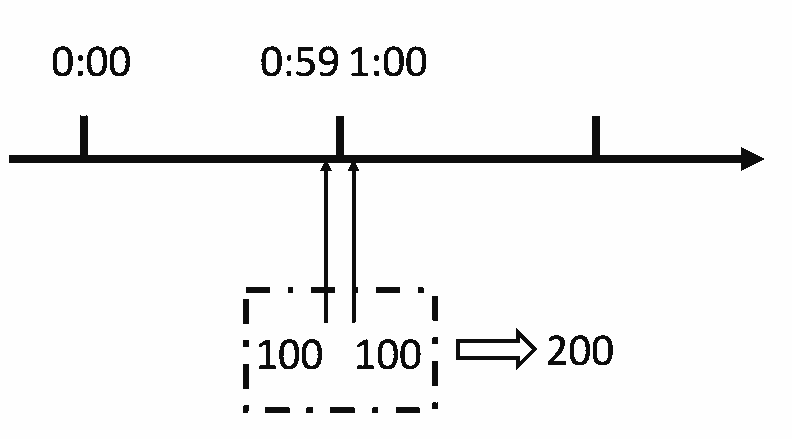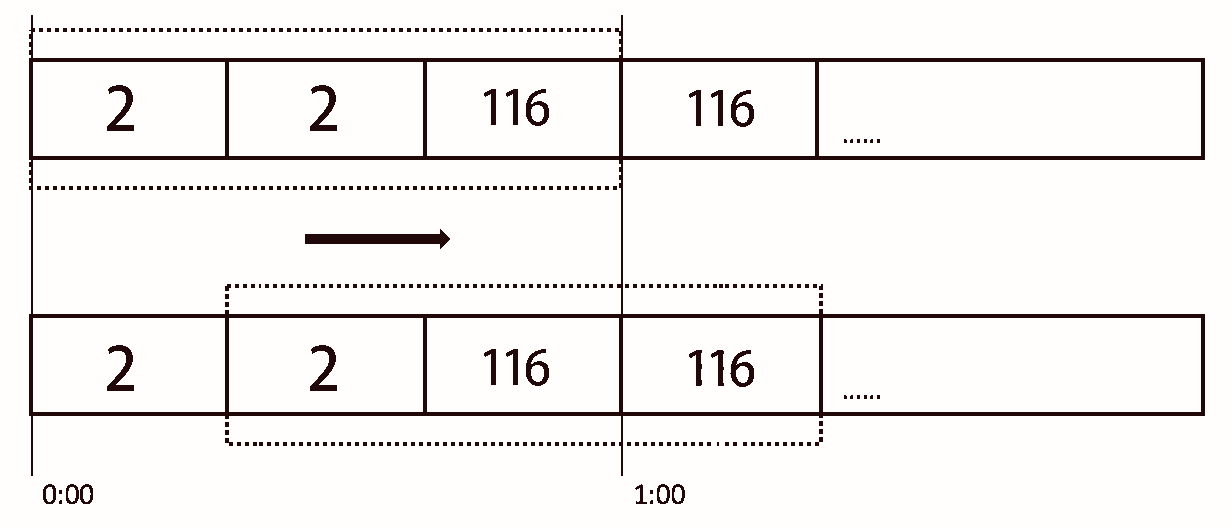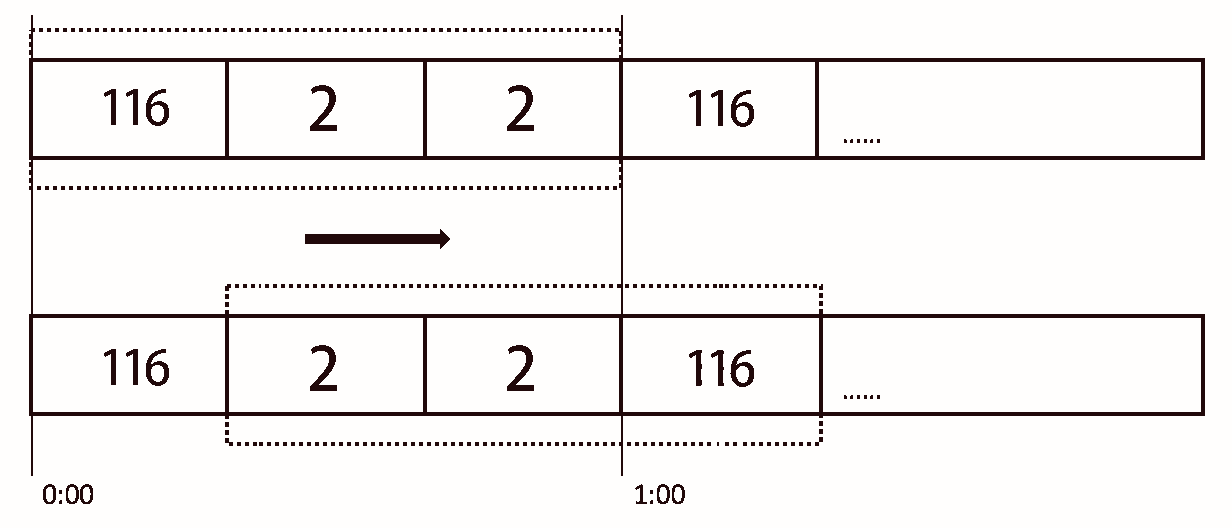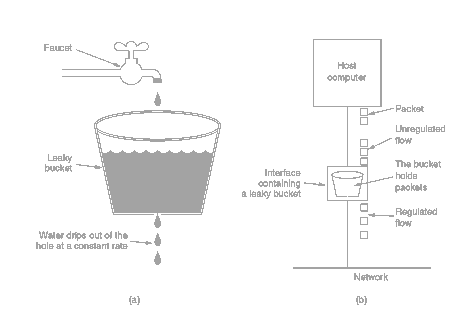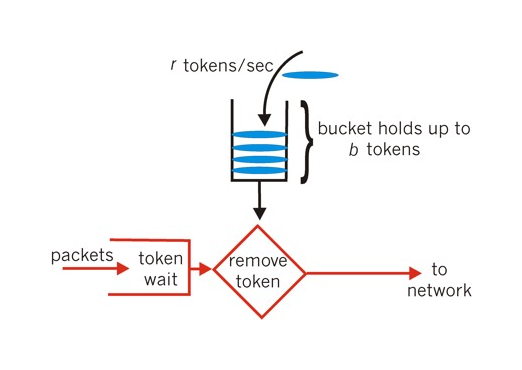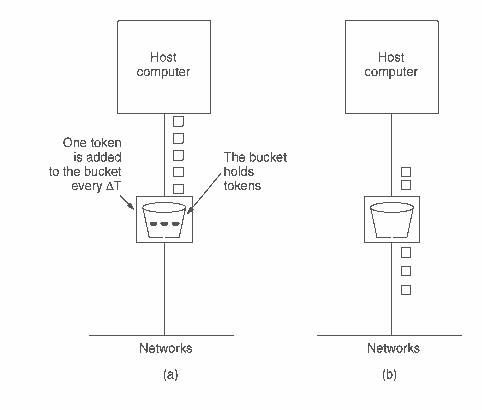背景 为了更好的说明几种算法,我们举个例子,下文就这个例子分别几种算法实现。
如何限制每分钟访问 /api/books 接口不能超过 120 次 ?
我们先定义一个接口:
1 2 3 4 interface RateLimiter public function access ( }
固定时间窗口算法 固定时间窗口算法又叫计数器算法,逻辑就是对固定时间段内的访问次数进行计数,如果计数结果超过次数限制,则拒绝访问。
固定时间窗口算法的劣势就在于其只关心时间段内的总访问次数,而忽略了瞬间集中请求的问题,换而言之,这种统计方法的粒度太粗了,然而我们无法保证请求在时间段内的分布是平均的。
举个例子,如果 A 用户访问接口的时间分布如下:
时间段
访问次数
00:00 ~ 00:30
20
00:30 ~ 01:00
100
01:00 ~ 01:30
100
01:30 ~ 02:00
20
显然在第一分钟,我们有 120 次请求,第二分钟也是 120 次请求,但是 00:30 ~ 01:30 这一分钟时间内,显然是请求书超过 120 次的,所以,这种情况虽然实现了需求,但是很勉强,粒度不够细。
PHP实现 1 2 3 4 5 6 7 8 9 10 11 12 13 14 15 16 17 18 19 20 21 22 23 24 25 26 27 28 29 30 31 32 33 34 35 36 37 38 39 class FixedWindowRateLimiter implements RateLimiter protected $prefix = "ratelimiter:" ; protected $key = null ; protected $window = null ; protected $limit = null ; public function __construct (string $key , int $window , int $limit { $this ->key = $this ->prefix . $key ; $this ->window = $window ; $this ->limit = $limit ; } public function access ( { $count = Redis ::get ($this ->key); if (!$count ) { Redis ::pipeline (function ($pipe ) { $pipe ->incr ($this ->key); $pipe ->expire ($this ->key, $this ->window); }); return true ; } if ($count >= $this ->limit) { return false ; } Redis ::incr ($this ->key); return true ; } }
调用:
1 2 3 4 $rateLimiter = new FixedWindowRateLimiter ("api:books" , 60 , 120 );if (!$rateLimiter ->access ()) { abort (404 ); }
Lua实现 1 2 3 4 5 6 7 8 9 10 11 12 13 14 15 16 17 local key = KEYS[1 ]local max_window_concurrency = tonumber (ARGV[1 ]) local window = tonumber (ARGV[2 ]) local curr_window_concurrency = tonumber (redis.call('get' , key) or 0 ) if current + 1 > limit then return false else redis.call("INCRBY" , key,1 ) if window > -1 then redis.call("expire" , key,window) end return true end
滑动时间窗口算法 固定时间窗口算法的问题是统计区间太大,限流不够精确,而且在第二个统计区间 01:00 ~ 02:00 时没有考虑与前一个统计区间的关系与影响(第一个区间后半段 + 第二个区间前半段也是一分钟)。
为了解决上面我们提到的临界问题,我们试图把每个统计区间分为更小的统计区间,更精确的统计计数。
如上图所示,我们把每分钟分为三份,每个小格是20秒,对每个小格都会分别计数:
时间段
访问次数
00:00 ~ 00:20
2
00:20 ~ 00:40
2
00:40 ~ 01:00
116
01:00 ~ 01:20
116
第一次统计,我们先看 01:00 ~ 02:00,计数 120 次,没有超过流量限制,然而在下一个 20 秒中,流量请求集中,在 00:20 ~ 01:20 这一分钟的统计范围内,流量超过了限制,则可以限制访问。
计数器算法其实就是滑动窗口算法。只是它没有对时间窗口做进一步地划分,所以只有1格;由此可见,当滑动窗口的格子划分的越多,那么滑动窗口的滚动就越平滑,限流的统计就会越精确。
PHP实现v1 1 2 3 4 5 6 7 8 9 10 11 12 13 14 15 16 17 18 19 20 21 22 23 24 25 26 27 28 29 30 31 32 33 34 35 36 37 38 39 40 41 42 43 class SlidingWindowRateLimiter implements RateLimiter public $remaining = null ; protected $prefix = "ratelimiter:sliding:" ; protected $key = null ; protected $window = null ; protected $limit = null ; protected $blocks = null ; public function __construct (string $key , int $window , int $limit , int $blocks { $this ->key = $this ->prefix . $key ; $this ->window = $window ; $this ->limit = $limit ; $this ->blocks = $blocks ; } public function access ( { $time = time (); $lastBlockTime = $time - $time % (ceil ($this ->window / $this ->blocks)); $firstBlockTime = $lastBlockTime - $this ->window; Redis ::zremrangebylex ($this ->key, '[0' , '(' .$firstBlockTime ); $blocks = Redis ::zrange ($this ->key, 0 , -1 , 'WITHSCORES' ); $scores = array_sum ($blocks ); $remaining = $this ->limit - $scores ; if ($remaining <= 0 ) { return false ; } Redis ::zincrby ($this ->key, 1 , $lastBlockTime ); $this ->remaining = $remaining - 1 ; return true ; } }
滑动窗口真的可以解决临界问题么?
我们再来看一个例子,在下面的例子中,流量主要集中于滑动窗口的 last block 和 窗口滑动后的 next block。
同样的请求情况,我们先把一个滑动窗口分为三格,窗口滑动前后都是符合限流要求的;然后我们把原来的每一格都分为两格,如图2,那么此时,窗口滑动前后的状况就不同了。
由此可见,滑动窗口算法很难完全符合限流需求,除非我们把统计区间变得更小,更甚至细化到每个请求,随之带来的问题是我们需要消耗更多存储空间。
PHP实现v2 1 2 3 4 5 6 7 8 9 10 11 12 13 14 15 16 17 18 19 20 21 22 23 24 25 26 27 28 29 30 31 32 33 34 35 36 37 38 39 40 41 42 class SlidingWindowRateLimiter implements RateLimiter public $remaining = null ; protected $prefix = "ratelimiter:sliding:" ; protected $key = null ; protected $window = null ; protected $limit = null ; protected $blocks = null ; public function __construct (string $key , int $window , int $limit , int $blocks { $this ->key = $this ->prefix . $key ; $this ->window = $window ; $this ->limit = $limit ; $this ->blocks = $blocks ; } public function access ( { $now = microtime (true ); $result = Redis ::pipeline (function ($pipe ) use ($now ) { $pipe ->zrangebyscore ($this ->key , 0, $now - $this ->window ); $pipe ->zrange ($this ->key, 0 , -1 ); $pipe ->zadd ($this ->key, $now , $now ); $pipe ->expire ($this ->key, $this ->window); }); $timestamps = $result [1 ]; $this ->remaining = max (0 , $this ->limit - count ($timestamps )); return $this ->remaining > 0 ; } }
Lua实现v2 1 2 3 4 5 6 7 8 9 10 11 12 13 14 15 local token = KEYS[1 ]local now = tonumber (ARGV[1 ])local window = tonumber (ARGV[2 ])local limit = tonumber (ARGV[3 ])local clearBefore = now - windowredis.call('ZREMRANGEBYSCORE' , token, 0 , clearBefore) local amount = redis.call('ZCARD' , token)if amount < limit then redis.call('ZADD' , token, now, now) end redis.call('EXPIRE' , token, window) return limit - amount
漏桶算法 漏桶算法(Leaky Bucket)是什么呢?大家都用过水龙头,打开龙头开关水就会流下滴到水桶里,而漏桶指的是水桶下面有个漏洞可以出水。如果水龙头开的特别大那么水流速就会过大,这样就可能导致水桶的水满了然后溢出。
而我们讨论的漏桶算法的思路也很简单,水龙头打开后流下的水(请求)以一定的速率流到漏桶里(限流容器),漏桶以一定的速度出水(接口响应速率),如果水流速度过大(请求过多)就可能会导致漏桶的水溢出(访问频率超过接口响应速率),这时候我们需要关掉水龙头(拒绝请求),下面是经典的漏桶算法图示:
PHP实现v3 1 2 3 4 5 6 7 8 9 10 11 12 13 14 15 16 17 18 19 20 21 22 23 24 25 26 27 28 29 30 31 32 33 34 35 36 37 38 39 40 41 42 class LeakyBucketRateLimiter implements RateLimiter protected $prefix = "ratelimiter:leaky:" ; protected $key = null ; protected $rate = null ; protected $capacity = null ; public function __construct (string $key , int $rate , int $capacity { $this ->capacity = $capacity ; $this ->key = $this ->prefix . $key ; $this ->rate = $rate ; } public function access ( { $time = time (); [$lastTime , $tokensPend ] = Redis ::hmget ($this ->key, 'last_time' , 'tokens_pend' ); $tokensHandled = ($time - $lastTime ) * $rate ; $tokensPend = max (0 , $tokensPend - $tokensHandled ); Redis ::hSet ($this ->key, 'last_time' , $time ); if ($tokensPend < $this ->capacity) { Redis ::hSet ($this ->key, 'tokens_pend' , $tokensPend + 1 ); return true ; } else { return false ; } } }
备注:
代码中对 redis 的操作存在并发问题,代码仅供参考程序逻辑,使用 redis+lua 脚本才是更靠谱的方案。
代码仅处理了漏桶满时溢出、漏桶不满时允许进入队列,但是实际请求的处理,还需要后续使用队列或延时处理保证漏桶流出的速率。
调用:
1 2 3 4 5 6 $mobile = "13888888888" ;$rateLimiter = new LeakyBucketRateLimiter (sprintf ("api:sms:send:%s" , $mobile ), 2 , 5 );if (!$rateLimiter ->access ()) { abort (404 ); } Queue ::smsSend ($mobile , $sms );
漏桶算法中必须保证请求处理速率是恒定的,不然限流就只能做到『漏桶满时溢出』的程度了。
Lua实现v3 1 2 3 4 5 6 7 8 9 10 11 12 13 14 15 16 17 local token = KEYS[1 ]local now = tonumber (ARGV[1 ])local rate = tonumber (ARGV[2 ])local capacity = tonumber (ARGV[3 ])local lastTime = tonumber (redis.call('HGET' , token, 'last_time' ) or 0 )local tokensPend = tonumber (redis.call('HGET' , token, 'tokens_pend' ) or 0 )tokensPend = math .max (0 , tokensPend - (now - lastTime) * rate) redis.call('HSET' , token, 'last_time' , now) if tokensPend < capacity then redis.call('HSET' , token, 'tokens_pend' , tokensPend + 1 ) return true end return false
漏桶算法有以下特点:
漏桶容量固定,漏洞出水速率是固定的(请求处理速度固定)
流量进入漏桶的速率是没有限制的(但不会立即处理,需要排队等待经过漏洞)
桶满了以后会溢出(拒绝新的请求)
漏桶算法限制的关键『请求处理速度』,即使遇到突发流量,我们的处理速度依然不变,因此会有一部分请求在排队,会等待延迟处理,但结果输出始终不会超出『请求处理速度』的限制。
令牌桶算法 令牌桶算法用来控制发送到网络上的数据的数目,并允许突发数据的发送。
令牌桶算法和漏桶算法的方向刚好是相反的,我们有一个固定的桶,桶里存放着令牌(token)。一开始桶是空的,系统按固定的时间(rate)往桶里添加令牌,直到桶里的令牌数满,多余的请求会被丢弃。当请求来的时候,从桶里移除一个令牌,如果桶是空的则拒绝请求或者阻塞。
PHP实现v4 1 2 3 4 5 6 7 8 9 10 11 12 13 14 15 16 17 18 19 20 21 22 23 24 25 26 27 28 29 30 31 32 33 34 35 36 37 38 39 class tokenBucketRateLimiter implements RateLimiter protected $prefix = "ratelimiter:tokenbucket:" ; protected $key = null ; protected $rate = null ; protected $capacity = null ; public function __construct (string $key , int $rate , int $capacity { $this ->capacity = $capacity ; $this ->key = $this ->prefix . $key ; $this ->rate = $rate ; } public function access ( { $time = time (); [$lastTime , $tokensLeft ] = Predis ::hmget ($this ->key, 'last_time' , 'tokens_left' ); $tokensAppend = ($time - $lastTime ) * $rate ; $tokensLeft = min ($this ->capacity, $tokensLeft + $tokensAppend ); Predis ::hSet ($this ->key, 'last_time' , $time ); if ($tokensLeft < 1 ) { return false ; } else { Predis ::hSet ($this ->key, 'tokens_left' , $tokensPend - 1 ); return true ; } } }
Lua实现v4 1 2 3 4 5 6 7 8 9 10 11 12 13 14 15 16 17 local token = KEYS[1 ]local now = tonumber (ARGV[1 ])local rate = tonumber (ARGV[2 ])local capacity = tonumber (ARGV[3 ])local lastTime = tonumber (redis.call('HGET' , token, 'last_time' ) or 0 )local tokensLeft = tonumber (redis.call('HGET' , token, 'tokens_left' ) or 0 )tokensLeft = math .min (capacity, tokensLeft + (now - lastTime) * rate) redis.call('HSET' , token, 'last_time' , now) if tokensLeft >= 1 then redis.call('HSET' , token, 'tokens_left' , tokensLeft - 1 ) return true end return false
往令牌桶中以固定速率增加令牌
令牌桶的容量有限,如果桶满了,新令牌溢出丢弃
如果桶中可用令牌不足时,该请求会被限流
令牌桶算法中流量的流入速率是不限制的,流出速率也是没有强制限制的(令牌消耗瞬间峰值是桶的大小),但是令牌的产生和积攒需要时间,因此既支持一定程度突发流量,又能满足总体限流的目标。
对比漏桶算法和令牌桶算法,我们发现,漏桶算法能够强行限制数据的传输速率,而令牌桶算法在能够限制数据的平均传输速率外,还允许某种程度的突发传输。
